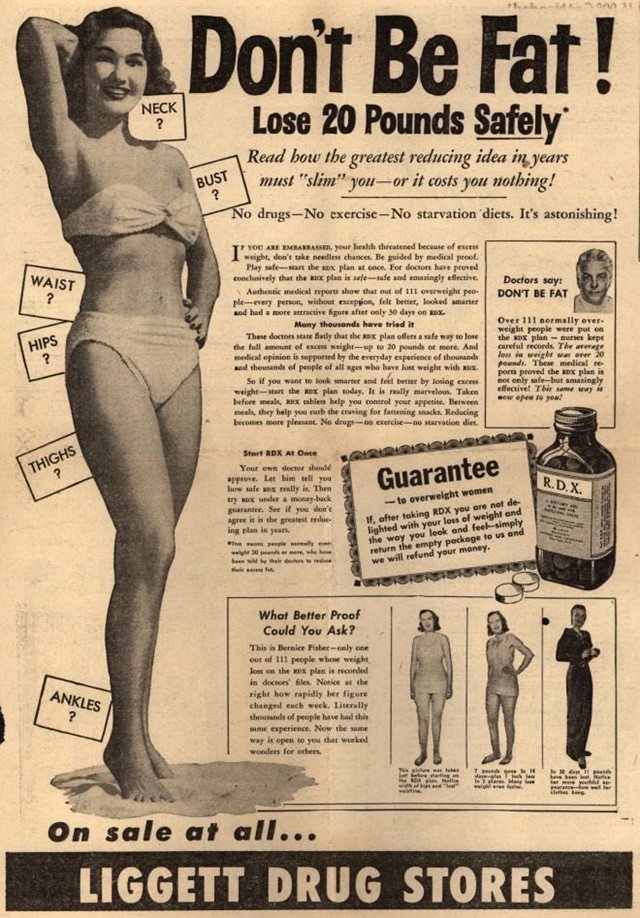From the amphetamine-fuelled “rainbow diet pills” of the 60s and the fen-phen “miracle” drug of the 80s to Ozempic in the present day, the history of weight-loss drugs is long and deadly
Welcome to Beauty School, the corner of Dazed Beauty dedicated to learning. From guides to histories, this is where we shed light on past subcultural movements and educate our readers on current trends and various goings-on.
“Everybody looks so great,” Jimmy Kimmel told the audience while hosting the Oscars earlier this month. “When I look around this room, I can’t help but wonder ‘Is Ozempic right for me?’”
Ozempic is everywhere; on the cover of magazines and splashed across New York’s subway, it’s the subject of countless memes and jokes, and, the stories are true, coursing through the veins of everyone in Hollywood and Manhattan who can get their hands on it. If weight loss were a religion, Ozempic would be its god, the haunting ‘Oh, oh, oh, Ozempic’ heard in its TV ad – a sinister reimagining of Pilot’s 1974 anthem Magic – its hymn. Much like the diet-entrenched, skinny-obsessed culture we live in, talk of Ozempic is everywhere.
Ozempic is the branded name for semaglutide, which is also sold under the labels of Wegovy and Mounjaro among others. A drug used to treat type 2 diabetes, it helps regulate blood sugar levels by mimicking the action of glucagon-like peptide-1 (GLP-1). It also greatly suppresses appetite and slows the rate at which the stomach empties, which has made it an extremely popular off-label medication for those wishing to shed some pounds.
Semaglutide has garnered a lot of traction over a very short period of time, so much so that diabetics are now struggling to get their hands on it thanks to consumer demand. Kim Kardashian – ever a barometer for Western beauty standards – is rumoured to have used Ozempic to fit into Marilyn Monroe’s dress at the Met Gala. While she denies the claims, she is undeniably thinner than recent years, and as the “BBL era” is declared over, it’s clear that body ideals have swung back from ‘slim-thick’ and returned to just slim.
But really, when has slim ever not been in? Diet pills and weight loss medication are nothing new – they have been around for over a century because women have always been pressured to conform to restrictive beauty ideals. Ozempic may be being hailed a “silver-bullet” weight loss miracle, but so was fen-phen in the 80s. Until it was found that the drug could cause untreatable and often fatal heart conditions. To look back over the history of diet pills and weight loss drugs, is to understand the deadly pressures to be thin that have long existed in our image-obsessed culture.
“The story of dinitrophenol goes back to World War I,” explains Dr Frank Greenway, chief medical officer and professor at Pennington Biomedical Research Centre. One of the first weight-loss drugs, dinitrophenol was first used in munitions factories as an explosive but after workers who came into contact with it were seen to lose weight, in the 1930s it was sold as “antiobesity therapy”. Not long after, however, dinitrophenol was shown to be incredibly unsafe at high doses, causing blindness and neuropathy; at very high doses, came death. By 1938, the FDA stated that it was “extremely dangerous and not fit for human consumption” and it was removed from the market. Its presence in diet pills in the UK is currently illegal, and is to be reclassified in 2023 as poison, such is its high toxicity.

In the 1940s, the amphetamine Benzedrine became the diet pill of choice. Originally sold as a decongestant, Benzedrine salts were then discovered to be powerful stimulants and when World War II came, the military in the US, Germany, UK and Japan placed large orders of the pills to keep soldiers going on the battlefield. As the war came to an end, pharmaceutical company Smith, Kline, and French shifted focus to a different demographic: housewives to whom they marketed amphetamines for weight loss. This was only the beginning of an amphetamine-fuelled race to thinness.
Next, in the 50s came human chorionic gonadotropin (HCG) – a hormone produced in the placenta of pregnant women – after boys with pituitary tumours weren’t going through puberty. In order to stimulate the process of going on the golden elevator to adolescence, they were given HCG, and were found to lose fat and gain muscle. After that came a study from Dr Albert T. W. Simeons which found that, if combined with a strict, low-calorie diet, people could lose 20lbs in six weeks. “But due to scepticism that the HCG was effective, there were several clinical trials that compared a diet with saline shots with a diet with HCG shots,” Dr Greenway explains. “It showed that both groups lost 20lbs in six weeks, and that HCG was unnecessary.” The FDA now has as part of the label for the HCG shots that it is not indicated or effective for treating obesity.
In 1960, Obetrol – a formulation of amphetamine mixed salts, including methamphetamine and dextroamphetamine – was approved by the FDA to treat obesity. Evidence that demonstrated the adverse side effects of amphetamines had been steadily accumulating thanks to the Benzedrine salts, and it didn’t take scientists long to figure out meth was incredibly harmful. By 1965, the FDA banned the inhalers completely and limited amphetamines to prescription use only. But, having been approved as a weight-loss drug, vast quantities of amphetamines like Obetrol started to be dispensed by diet doctors. Civilian use went through the roof and by 1970, 5 per cent of Americans (or roughly 9.7 million) were using some kind of prescription amphetamine, the so-called “rainbow diet pills”.
The ozempic ads plastered across the Times Square subway station can fuck all the way off. pic.twitter.com/dPUU7P6AU2
— Sophie Vershbow (@svershbow) April 2, 2023
As well as weight loss, many people were using pills like Obetrol as recreational drugs. In 1963, Andy Warhol received a prescription for Obetrol and it became his drug of choice (Warhol was on his way to the drug store to pick up his prescription Obetrol on the morning he was shot by Valeria Solanas). By now, widespread consumption helped to illuminate not just how truly addictive amphetamines were, but also their negative health effects, like psychosis, hallucinations and death. Not that it mattered. Profits were astronomical; one dispensing diet doctor paid $71 for 100,000 amphetamine-containing tablets and sold them for $12,000. Although not banned by the FDA, Obetrol underwent reformulations, eventually rebranding and sold as Adderall, of which has never received FDA approval for weight loss.
Then came 1985: the year when the National Institutes for Health declared obesity to be a chronic disease and, as such, required chronic treatment. It was also the year that fen-phen came onto the market. The latter (phentermine) and the former (fenfluramine) were shown to help people lose weight – and a lot of it. But, due to regulations, it wasn’t supposed to be used for longer than 12 weeks; the women who did, developed cases of heart valve abnormalities. Due to the way in which serotonin was affecting the body, it was suspected that fenfluramine was to blame, and unsurprisingly, this led to it being taken off the market. In 1999, American Home Products (now Wyeth) agreed to pay up to $3.75 billion to settle the numerous lawsuits the drug faced in the USA, in what was believed to be the largest legal settlement ever against a pharmaceutical company at the time. It’s estimated that Wyeth has since spent $10 billion in total damages.
1999 brought the next iteration of a weight-loss drug: orlistat, often sold under the brand Xenical. Though understood to be safe – and is still FDA-approved – Xenical inhibits the digestion of fat, leading to 30 percent of the fat in the diet passing out in the stool as oil. “People can develop anal leakage, pass oil when they think it is air, and sometimes lose control of their bowels,” explains Dr Greenway. “This is not dangerous, but it can be very socially embarrassing. While orlistat is approved for children and adolescents, overweight children are stigmatised, and if they have faecal accidents, it just makes the stigmatisation worse and so it hasn’t been prescribed much.”
In the 00s came lorcaserin, which was marketed under the brand name Belviq. It was approved by the FDA in 2012, but within a mere eight years, the FDA requested that its manufacturer voluntarily withdraw the drug from the US market because “a safety clinical trial showed an increased occurrence of cancer”. And now we have semaglutide, alongside a range of weight loss jabs available from the high street.
The long-term effects of semaglutide are as yet unknown, particularly when it comes to weight-loss purposes, although the history of weight-loss drugs counsels extreme caution. But its rapid rise in popularity says a lot about where we as a culture are right now when it comes to attitudes around weight. Thin is purportedly “in again”, but given society’s rapid embrace of a size-zero aesthetic and our repeated willingness to try weight-loss drugs, did coveting thinness ever really go away? Despite the body positivity movement from the last few years, there is still a long way to go before we move past the fatphobia that is so pervasive in our obesogenic lives. In New York Magazine’s cover story about Ozempic, Aubrey Gordon is quoted as saying that the hype around the drug boils down to: “Can we finally be rid of fat people? Can we finally stop having fat people around so I don’t have to look at them anymore?”




